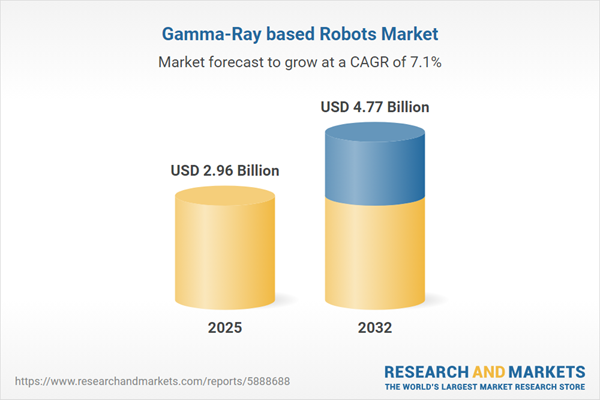Speak directly to the analyst to clarify any post sales queries you may have.
Gamma-ray based robotics are transforming industrial safety and compliance strategies, offering reliable automation that meets evolving standards in manufacturing, energy, and infrastructure. As operational risks increase and regulations grow more complex, decision-makers are prioritizing advanced gamma-ray technology to achieve sustainable performance.
Market Snapshot: Gamma-Ray Based Robots Market Growth
The global gamma-ray based robots market is experiencing robust expansion, with a projected value rise from USD 2.76 billion in 2024 to USD 2.96 billion in 2025, and a potential USD 4.77 billion by 2032. This equates to a compound annual growth rate (CAGR) of 7.06%.
Key market drivers include innovations in gamma-ray imaging and seamless integration with intelligent robotic platforms. Organizations across sectors leverage these advances to streamline inspection processes, strengthen operational continuity, and address strict compliance expectations. The rapid adoption of gamma-ray based robots is significantly improving inspection efficiency, supporting preventative maintenance, and minimizing workforce exposure to hazardous environments. As executive focus shifts toward automation as a foundation for long-term resilience, comprehensive solutions capable of addressing regulatory pressures are in high demand.Scope & Segmentation: Gamma-Ray Based Robotics
This report provides actionable insights for executives considering investments or deployment of gamma-ray based robotics, offering a clear segmentation to aid strategic market evaluation and entry plans. The following areas are examined in depth:
- Robot Types: Fixed gantry, mounted, mobile, articulated, aerial, and ground-based robots are featured, supporting accurate inspection and enabling safe operation even in challenging or hard-to-access environments.
- Technology: The sector employs gas-filled detectors, scintillation counters, and semiconductor-based systems. These are engineered for use with key gamma-ray sources such as Caesium-137, Cobalt-60, and Iridium-192 across a full range of industrial use cases.
- Application Domains: Gamma-ray robotic systems are applied in casting and weld inspection, pipeline assessments, healthcare diagnostics, oil and gas monitoring, nuclear research, and infrastructure security. This highlights their centrality in non-destructive testing and real-time anomaly detection across multiple sectors.
- End Users: The market serves governmental agencies, defense, healthcare providers, automotive and aerospace firms, electronics manufacturers, and research organizations, many of whom face rising automation and regulatory requirements.
- Regional Coverage: The report evaluates dynamics across the Americas (United States, Canada, Brazil), EMEA (including the UK, Germany, France, Middle East, and South Africa), and Asia-Pacific (with China, India, Japan, Australia, and South Korea), noting the impact of regulatory, workforce, and infrastructure variations on strategy.
- Company Analysis: Strategies and positioning of leading organizations including Mirion Technologies, RedZone Robotics, Energy Robotics, QinetiQ Group, Oceaneering International, Jacobs Engineering Group, Orano Group, Leonardo S.p.A., Babcock International Group, and Westinghouse Electric Company are discussed, highlighting innovation and competitive trends in the evolving market environment.
Key Takeaways for Senior Decision-Makers
- Gamma-ray robotics enable higher levels of compliance and operational safety, reducing human risk and supporting stable autonomous workflows in high-pressure settings.
- Adaptive architectures and sensor integrations give businesses the flexibility to customize robotics to distinct industrial requirements and mission profiles.
- Integrating artificial intelligence with real-time gamma-ray detection enhances the reliability and safety of critical operations, aiding risk management in complex environments.
- Regional regulatory alignment simplifies global deployment for multinational organizations and accelerates the value delivery of new automation initiatives.
- Collaborating with regional partners and strengthening domestic supply chains bolster procurement reliability and agility as policy and market conditions shift.
- The deployment of both stationary and mobile gamma-ray robots improves preventative maintenance, accelerates incident response, and provides comprehensive oversight in multifaceted facilities.
Tariff Impact: United States Market Considerations
Current tariff measures on robotics and semiconductor components are prompting U.S. firms to reorient toward domestic supply sources and build local manufacturing capability. This approach is increasing supply chain stability and supporting continued delivery in a shifting regulatory climate.
Methodology & Data Sources
Primary research from robotics vendors, end-user organizations, and industry leaders was combined with peer-reviewed studies, patent data, compliance records, and company reports. Cross-validation guarantees actionable, reliable insights for business decision-makers.
Why This Report Matters: Strategic Outcomes
- Enables executive teams to realign investment strategies and operational models with industry-wide trends and updated regulatory mandates for gamma-ray robotics.
- Equips technical and management teams to adapt quickly to regulatory and market changes using modular and AI-enabled robotics for effective risk mitigation.
- Supports the cultivation of dependable supplier relationships and operational continuity, building a foundation for performance amid fluctuating industrial and policy landscapes.
Conclusion
This report is a practical guide for leaders seeking to enhance compliance, advance process resilience, and implement next-generation automation in today’s industrial environments.
Additional Product Information:
- Purchase of this report includes 1 year online access with quarterly updates.
- This report can be updated on request. Please contact our Customer Experience team using the Ask a Question widget on our website.
Table of Contents
3. Executive Summary
4. Market Overview
7. Cumulative Impact of Artificial Intelligence 2025
Companies Mentioned
The companies profiled in this Gamma-Ray based Robots market report include:- Mirion Technologies, Inc.
- RedZone Robotics Ltd.
- Energy Robotics GmbH
- QinetiQ Group plc
- Oceaneering International, Inc.
- Jacobs Engineering Group Inc.
- Orano Group
- Leonardo S.p.A.
- Babcock International Group plc
- Westinghouse Electric Company LLC
Table Information
| Report Attribute | Details |
|---|---|
| No. of Pages | 181 |
| Published | October 2025 |
| Forecast Period | 2025 - 2032 |
| Estimated Market Value ( USD | $ 2.96 Billion |
| Forecasted Market Value ( USD | $ 4.77 Billion |
| Compound Annual Growth Rate | 7.0% |
| Regions Covered | Global |
| No. of Companies Mentioned | 11 |









